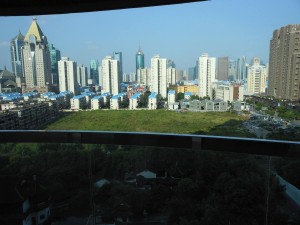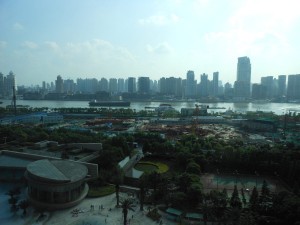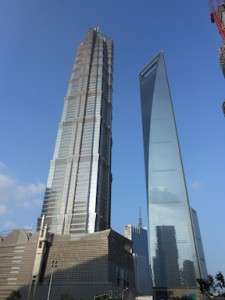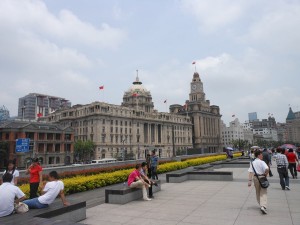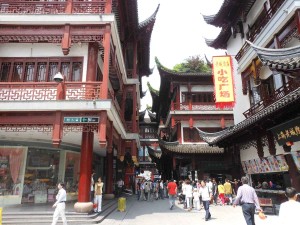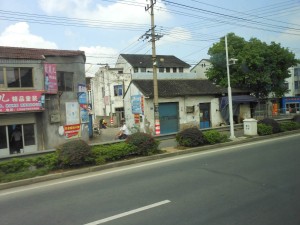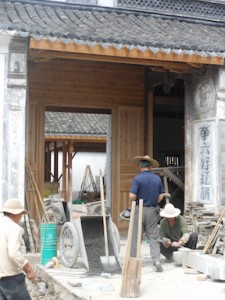Preservation conversations: Reflections on a visit to Shanghai and Cixi, China
07 September 2012 – Will Walker
I was fortunate enough to be invited to China earlier this summer for a conference on urban planning, historic preservation, and cultural development. With so much hyperbole in the press about the “Chinese century,” I expected to be swept away by the stunning economic growth of the Asian giant. At the same time, I was wary of being too credulous, so impressed by superficial factors that I missed the deeper issues and problems beneath the surface. Because this was to be my first time in China and my visit would be brief–only ten days–I knew, however, that this deeper perspective would be difficult to achieve.
I was particularly interested in the relationship between economic development and historic preservation, as well as the human costs of urban planning. As part of a group of scholars invited to discuss the past and present of “quality cities,” I was attuned to the benefits and drawbacks of development.
My itinerary took me first to Shanghai, an excellent place to explore urban development and historic preservation in China. Amazingly, twenty-three million people live there, which means it is three times the size of New York City, and like New York, it is a city driven by construction and real estate. While in Shanghai, I stayed with a friend who lives in Pudong, which is the newer part of the city on the east bank of the Huangpu River. His high-rise apartment was a great place to begin pondering urban development. Between his apartment complex and the river, a new high-rise was under construction on land that was supposed to have remained green space.
Looking the other direction (image at top), away from the river, I could see a mixture of residential and commercial buildings. A bit of traditional architecture had survived as a restaurant and garden; then a little further on were low-rise apartments, and, remarkably, a vacant lot with a few shanties on it and what appeared to be a scrap yard. Walking around Pudong, I encountered the city’s iconic buildings—the two, soon to be three, towering skyscrapers that seemed so big as to be unreal—and it was immediately evident that Pudong could be viewed as a metonym for the rapid growth and modernization of China.
On the Puxi side of the river, the process of development had clearly been more mixed. The Bund, the center of European trading during the quasi-colonial period, remains a highly visible part of the city because of its location on the west bank of the river. With a river walk that attracts many tourists, the Bund is a great place to think about the history of Shanghai through its historic structures. Other commercial and residential parts of the city have not received the same treatment, with demolition-based development trumping any impulse to preserve older structures.
There are exceptions, though—most notably in Xintiandi, where historic shikumen (stone-gate) houses have been converted into an upscale shopping district, and Tianzifang, an artsy neighborhood filled with cafes and studios. Even with these preserved areas, however, it was difficult to get a sense of “Old Shanghai”; at the same time, I did not feel like I was walking around in a wholly new and de-historicized landscape. In fact, as a tourist, I found the experience of the built environment mostly satisfying, as the variety of residential and commercial spaces was consistently intriguing.
Moving beyond Shanghai, the other part of my trip took me a little more off the beaten path. About two hours south of Shanghai is the small city of Cixi–small, that is, by Chinese standards (with its 1.2 million residents it is certainly not small by U.S. standards). Here I joined a group of scholars from the United States, Asia, and Europe to discuss cultural and economic development in urban areas. My colleague, a sociologist who specializes in urban architecture, organized the conference in cooperation with Cixi’s local research institute. I was there to talk about museums’ role in urban development in the United States over the past fifty years. (The details of the conference may follow in a future post, but for now I will continue with my theme of historic preservation.)
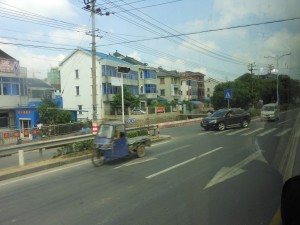
A street scene from Cixi shot from our tour bus. Visible at the center are several characteristic “triple decker” buildings.
Cixi is a prosperous city with a large amount of manufacturing–evidently workers here make most of the lighters that are sold around the world. For me, Cixi is akin to Lowell, Massachusetts–a manufacturing center that is within the orbit of a larger city that is also a major tourist attraction. It is itself not presently a tourist destination, although local officials hope to change that. To this end, they have an interest in cultivating attractions, including traditional architecture, which will appeal to tourists, both foreign and domestic.
This is a challenge, however, because a large amount of demolition-based development is also occurring in the area. Riding around the city in a tour bus with my colleagues, lots of activity was clearly visible–numerous motorbike repair shops, small factories, and residences were packed tightly together along the main roads. According to one of our guides, many of the structures are mixed residential and commercial spaces, with families operating small factories within. One of the characteristic types of structures in the city was the triple-decker, which bore a superficial resemblance to the structures I knew from living in the Boston area. They were about twice as big as those Boston structures, however, and were not strictly residential. The city was also filled with small canals, the present function of which I was unable to ascertain. Everywhere I looked the raw force of economic activity seemed in evidence. In retrospect, however, I recognize that this perception could easily have been shaded by my preconceptions of China’s economic strength. Without spending more time in the city and speaking with more people who live and work there, I really have no way of knowing what the reality is.
Making Cixi into a tourist draw seems a tall order. If it is truly as alive economically as our guides indicated then it would not fit the model of U.S. cities that have pursued heritage tourism to replace dying or departed industries. Instead, tourism would be super-imposed over an active economy. In this context, perhaps something akin to factory tours would be appropriate. My understanding, however, is that local officials are thinking of something very different. Our group saw a traditional village whose residents were being relocated and buildings rehabbed to house cafes, shops, and other tourist attractions. We also saw plans for a five-star resort and visited a large nature park.
All of these things indicated that they intend to transform portions of the city and its surrounding region into a carefully constructed “experience” for tourists. Rather than highlighting the existing industrial character of the city, they are building new or renovated spaces that will provide an escape from the bustling activity of the city and occlude visitors’ understandings of the positive and negative consequences of economic development.
These observations and musings should not be taken as well-formed conclusions about the nature of historic preservation or cultural and economic development in Shanghai and Cixi. I do not pretend to be an expert on such issues in China (nor in the United States for that matter). Instead, I’m hoping to use this blog platform to think through my own still inchoate ideas about what is going on in China and to solicit input from readers who may have more experience than I do. I’m planning to return to Shanghai and Cixi in the near future, hopefully with more knowledge and insight than I had on my first visit. This, I hope, is the beginning of that process.
~ Will Walker is Assistant Professor of History in the Cooperstown Graduate Program at SUNY Oneonta.




